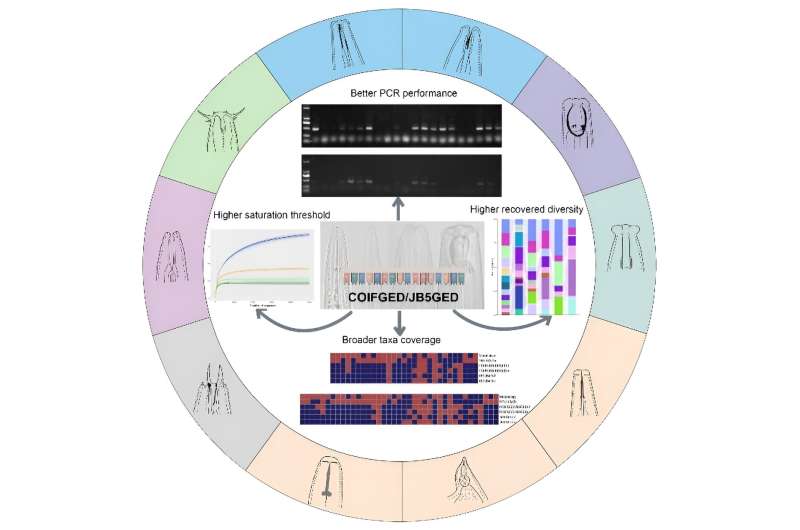This article has been reviewed according to Science X's editorial process and policies. Editors have highlighted the following attributes while ensuring the content's credibility:
fact-checked
proofread
Single degenerated primer significantly improves COX1 barcoding performance in soil nematode profiling

Microscopic nematodes play important roles in the soil ecosystem and often serve as bioindicators of soil health. The identification of soil nematodes is often difficult due to their limited diagnostic characters and high phenotypic plasticity. The DNA barcoding and metabarcoding techniques are promising but lack universal primers, especially for mitochondrial COX1 gene.
In a new study, a degenerated COX1 forward primer COIFGED was developed. The primer pair COIFGED/JB5GED significantly improved species identification and thus can be supplementary or alternative to the conventional 18S metabarcoding. The researchers' findings were published in Soil Ecology Letters.
A series of studies on the soil nematode metabarcoding have been conducted by Plant Nematode laboratory at the Nanjing Agriculture University, and many interesting findings have been obtained. For example, a proportion of the non-Nematoda ASVs were assigned to soil eukaryotes such as Arthopoda and Ascomycota. These organisms may represent a part of nematode gut microbiome as soil nematodes feed on a large variety of food sources, alternatively their degraded debris can be carried by nematode cuticles.
Researchers also found that the relative abundances recovered from metabarcoding data were not proportional to morphological observation. The variability in these recovered-abundance may be attributed to primer biases, as some nematode taxa lack an adequate primer-binding site due to mutations in the primer-binding regions, especially for the COX1 genes.
Professor Qing said, "We designed four degenerated sites in primer with two Ns (contains all four nucleotides) in hyper-variable sites, aiming to improve the primer binding efficiency for the hyper-variable COX1 gene." Together with existing reverse primer JB5GED, the new primer pair outperforms widely the commonly used JB3/JB4.5 primers both in broader taxon recovery and higher amplicon production.
"We observed a significant proportion of unidentified ASVs, others were assigned unexpected taxa resulting in many mock community taxa unrecovered. Based on a phylogenetic reconstruction, we confirmed that many of the unidentified ASVs had Nematoda origin emphasizing the importance of database coverage, and comprehensive work that will need to take place towards nematode COX1 database expansion before the COX1 gene can be used as a metabarcoding marker."
Currently, driven by a broad taxon representation in databases, 18S rRNA has been the most commonly used barcoding gene marker. However, 18S rRNA has been shown to provide limited taxonomic resolution, especially species or even genus level for some nematode groups. The hyper-variable mitochondrial COX1 gene is a suitable gene to discriminate among closely related species or even phylogeographic groups within a single species. The newly designed COX1 primer significantly improved the binding efficiency, and thus can be supplementary to the conventional 18S metabarcoding in the future.
More information: Yincai Ren et al, A single degenerated primer significantly improves COX1 barcoding performance in soil nematode community profiling, Soil Ecology Letters (2023). DOI: 10.1007/s42832-023-0204-4
Provided by Frontiers Journals


















